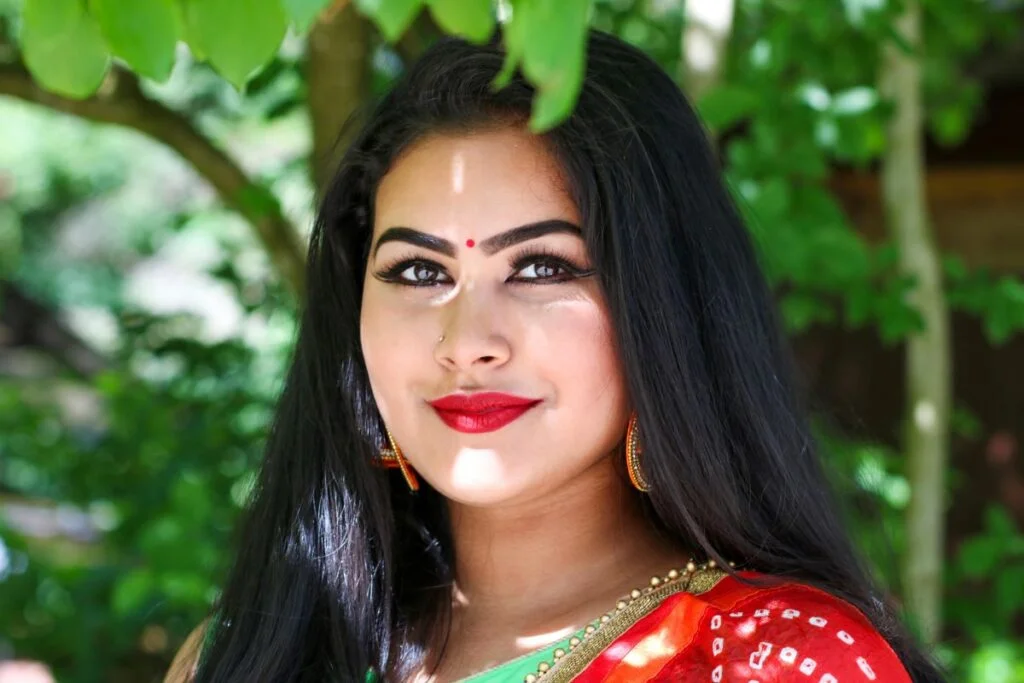
The bindi, a decorative mark worn on the forehead, is deeply rooted in Hindu culture, symbolizing marital status, good fortune, and the “third eye” or ajna chakra—a center of intuition and spiritual awareness. While its cultural significance has evolved over centuries, modern science has also begun to explore the physiological and psychological benefits of applying a bindi at this specific location.
Traditional and Cultural Significance
Marital Status & Auspiciousness
In Hindu tradition, a red bindi is traditionally worn by married women as a mark of their marital status, prosperity, and well-being. This belief is linked to ancient customs where vermilion (sindoor) or kumkum was used to invoke the blessings of the gods for a happy and harmonious married life. In some cultures, widows refrain from wearing a red bindi, replacing it with a black one or none at all.
Spiritual & Religious Symbolism
The area between the eyebrows, where the bindi is placed, is associated with the ajna chakra, also known as the “third eye.” According to esoteric Hindu and Buddhist traditions, this chakra governs intuition, wisdom, and spiritual vision. It is believed that focusing on this point during meditation enhances mental clarity and self-awareness.
Hindu priests often mark the foreheads of devotees with a red powder (kumkum) upon entering temples, reinforcing the idea that this mark serves as a spiritual reminder to keep divine consciousness at the center of one’s thoughts.
Symbol of Feminine Energy (Shakti)
In certain interpretations, the red bindi symbolizes Shakti, the divine feminine energy that represents power, creativity, and transformation. It is an emblem of the goddess energy within every woman, connecting her to cosmic forces.
A Cultural Tradition Beyond Religion
While primarily linked to Hinduism, the bindi is also worn by women in Jain, Buddhist, and Sikh communities as a cultural identifier rather than a religious mark. Over time, the bindi has transcended its original meaning and is now worn across South Asian communities irrespective of religion.
Scientific Benefits of Wearing a Bindi
1. Activation of the Ajna Chakra (Third Eye Stimulation)
From a yogic perspective, the ajna chakra is a focal point for mental clarity and higher consciousness. The pressure applied when placing a bindi is believed to help stimulate this energy center, potentially enhancing concentration, memory, and intuition.
2. Acupressure & Stress Relief
The area between the eyebrows is an important acupressure point, often targeted in therapies like Ayurveda, acupressure, and reflexology. Applying slight pressure to this region may help:
✔️ Relieve stress and anxiety
✔️ Improve blood circulation to the forehead and eyes
✔️ Reduce headaches and mental fatigue
✔️ Promote better sleep and relaxation
Scientific research suggests that stimulating GV24.5 (Yintang Point), located between the eyebrows, can have calming effects similar to meditation and deep breathing exercises (Kumar, 2013).
3. Cooling & Detoxification Effects
Traditional bindis made from sandalwood paste, turmeric, or kumkum contain natural cooling properties. Ayurvedic practices suggest that these ingredients help:
✔️ Regulate body heat
✔️ Reduce inflammation
✔️ Protect against skin infections
Sandalwood, in particular, has been studied for its antimicrobial and calming effects, making it beneficial for skin health (Singh et al., 2017).
Evolution of the Bindi: From Ritual to Fashion
Ancient Origins & Rituals
Some historians trace the origins of the bindi to ancient blood sacrifice rituals, where offerings to the gods involved marking the forehead with blood. Over time, this evolved into a more symbolic practice using red powders like vermillion (sindoor) and turmeric-based kumkum.
The Tilak: A Parallel Tradition
The bindi shares similarities with the tilak, a forehead mark traditionally worn by men and women to denote religious sects. Shaivites (followers of Shiva) typically wear horizontal ash stripes, while Vaishnavites (followers of Vishnu) sport vertical lines. Unlike the bindi, tilaks are primarily associated with religious devotion rather than social status.
Modern Trends & Innovations
Over the past century, the bindi has transformed from a strictly cultural or religious symbol to a bold fashion statement:
🔸 1930s–1940s: Minimalist small red dots popularized by artist Amrita Sher-Gil and actress Shanta Hublikar.
🔸 1950s–1970s: Liquid kumkum and stick-on bindis revolutionized ease of application.
🔸 1980s–Present: Felt-based bindis, gemstones, and intricate designs became mainstream, worn by women regardless of marital status.
Today, bindis come in various colors, shapes, and designs, making them a versatile accessory that blends tradition with contemporary aesthetics.
Conclusion
The bindi is much more than an ornamental forehead mark—it is a symbol of spirituality, cultural identity, and energy balance. While its traditional meanings remain deeply rooted in Hindu customs, modern science acknowledges its potential benefits for stress relief, cognitive function, and emotional well-being.
From its sacred origins to its modern evolution as a global fashion trend, the bindi continues to be a timeless representation of tradition, beauty, and science.
References
- Kumar, S. (2013). Acupressure and Its Role in Mental Health. Journal of Alternative Medicine Studies.
- Singh, P., et al. (2017). The Therapeutic Effects of Sandalwood and Its Essential Oil on Skin and Mind. International Journal of Ayurveda Research.
- Chakrabarti, A. (2015). Cultural Symbolism and Scientific Relevance of the Bindi. Indian Journal of Cultural Studies.










